Optimizing Photoelectrochemical UV Imaging Photodetection: Construction of Anatase/Rutile Heterophase Homojunctions and Oxygen Vacancies Engineering in MOF-Derived TiO2
Abstract
:1. Introduction
2. Results and Discussion
3. Materials and Methods
3.1. Synthesis of MIL-125(Ti)
3.2. Synthesis of MOF-Derived TiO2
3.3. Assembling of PEC UVPDs
3.4. Characterizations
4. Conclusions
Supplementary Materials
Author Contributions
Funding
Institutional Review Board Statement
Informed Consent Statement
Data Availability Statement
Conflicts of Interest
References
- Zhao, C.C.; Wang, D.B.; Cao, J.M.; Zeng, Z.; Zhang, B.K.; Pan, J.W.; Liu, D.H.; Liu, S.H.; Jiao, S.J.; Chen, T.Y.; et al. Highly efficient 1D p-Te/2D n-Bi2Te3 heterojunction self-driven broadband photodetector. Nano Res. 2024, 17, 1864–1874. [Google Scholar] [CrossRef]
- Nguyen, T.M.H.; Shin, S.G.; Choi, H.W.; Bark, C.W. Recent advances in self-powered and flexible UVC photodetectors. Exploration 2022, 2, 20210078. [Google Scholar] [CrossRef]
- Liao, M.Y.; Koide, Y. High-performance metal-semiconductor-metal deep-ultraviolet photodetectors based on homoepitaxial diamond thin film. Appl. Phys. Lett. 2006, 89, 113509. [Google Scholar] [CrossRef]
- Zhou, L.; Yu, K.; Yang, F.; Cong, H.; Wang, N.; Zheng, J.; Zuo, Y.H.; Li, C.B.; Cheng, B.W.; Wang, Q.M. Insight into the effect of ligand-exchange on colloidal CsPbBr3 perovskite quantum dot/mesoporous-TiO2 composite-based photodetectors: much faster electron injection. J. Mater. Chem. C 2017, 5, 6224–6233. [Google Scholar] [CrossRef]
- Zhang, H.J.; Abdiryim, T.; Jamal, R.; Li, J.X.; Liu, H.L.; Kadir, A.; Zou, D.N.; Che, Y.Z.; Serkjan, N. Self-powered TiO2 NRs UV photodetectors: Heterojunction with PTTh and enhanced responsivity by Au nanoparticles. J. Alloy. Compd. 2022, 899, 163279. [Google Scholar] [CrossRef]
- Zheng, W.J.; Li, X.C.; He, G.H.; Yan, X.M.; Zhao, R.; Dong, C.X. A highly responsive UV photodetector based on hierarchical TiO2 nanorod/nanoparticle composite. RSC Adv. 2014, 4, 21340–21346. [Google Scholar] [CrossRef]
- Zhou, J.X.; Chen, L.; Wu, J.J.; Lu, Z.C.; Liu, F.; Chen, X.D.; Xue, P.; Li, C.S.; Wei, L.; Wu, G.; et al. High-sensitivity self-powered photodetector fibers using hierarchical heterojunction photoelectrodes enable wearable amphibious optoelectronic textiles. Nano Lett. 2023, 23, 11297–11306. [Google Scholar] [CrossRef]
- Li, M.J.; Wang, Z.L.; Jin, Y.H.; Yang, H.T.; Zhang, L.H.; Li, H.J.; Wang, J.P.; Fan, S.S.; Li, Q.Q. Highly efficient visible-blind ultraviolet photodetector based on scalably produced titanium dioxide nanowire arrays. Nano Lett. 2023, 23, 6059–6066. [Google Scholar] [CrossRef]
- Kang, Y.; Wang, D.H.; Gao, Y.Z.; Guo, S.Q.; Hu, K.J.; Liu, B.Y.; Fang, S.; Memon, M.H.; Liu, X.; Luo, Y.M.; et al. Achieving record-high photoelectrochemical photoresponse characteristics by employing Co3O4 nanoclusters as hole charging layer for underwater optical communication. ACS Nano 2023, 17, 3901–3912. [Google Scholar] [CrossRef] [PubMed]
- Jiang, X.S.; Fang, T.; Tao, J.J.; Zhang, Y.C.; Zhang, Y.Y.; Shi, Y.H. 1D/2D/0D mixed-dimensional TiO2/ZnO/Ag core-shell nanowires for high-performance uv-vis photoelectrochemical photodetectors. J. Phys. Chem. C 2023, 127, 3698–3705. [Google Scholar] [CrossRef]
- Tan, C.Y.; Wang, H.H.; Zhu, X.D.; Gao, W.S.; Li, H.; Chen, J.W.; Li, G.; Chen, L.J.; Xu, J.M.; Hu, X.Z.; et al. A self-powered photovoltaic photodetector based on a lateral WSe2-WSe2 homojunction. ACS Appl. Mater. Interfaces 2020, 12, 44934–44942. [Google Scholar] [CrossRef]
- Wang, F.K.; Pei, K.; Li, Y.; Li, H.Q.; Zhai, T.Y. 2D homojunctions for electronics and optoelectronics. Adv. Mater. 2021, 33, 2005303. [Google Scholar] [CrossRef] [PubMed]
- Ruan, X.W.; Cui, X.Q.; Cui, Y.; Fan, X.F.; Li, Z.Y.; Xie, T.F.; Ba, K.K.; Jia, G.R.; Zhang, H.Y.; Zhang, L.; et al. Favorable energy band alignment of TiO2 anatase/rutile heterophase homojunctions yields photocatalytic hydrogen evolution with quantum efficiency exceeding 45.6%. Adv. Energy Mater. 2022, 12, 2200998. [Google Scholar] [CrossRef]
- Chen, C.; Tuo, Y.X.; Lu, Q.; Lu, H.; Zhang, S.Y.; Zhou, Y.; Zhang, J.; Liu, Z.N.; Kang, Z.X.; Feng, X.; et al. Hierarchical trimetallic Co-Ni-Fe oxides derived from core-shell structured metal-organic frameworks for highly efficient oxygen evolution reaction. Appl. Catal. B-Environ. 2021, 287, 119953. [Google Scholar] [CrossRef]
- Men, Y.; Liu, P.; Meng, X.; Pan, Y. Recent progresses in material fabrication and modification by cold plasma technique. FirePhysChem 2022, 2, 214–220. [Google Scholar] [CrossRef]
- Hussain, M.Z.; Bahri, M.; Heinz, W.R.; Jia, Q.L.; Ersen, O.; Kratky, T.; Fischer, R.A.; Zhu, Y.Q.; Xia, Y.D. An in situ investigation of the thermal decomposition of metal-organic framework NH2-MIL-125 (Ti). Microporous Mesoporous Mat. 2021, 316, 110957. [Google Scholar] [CrossRef]
- Hussain, M.Z.; Yang, Z.X.; van der Linden, B.; Huang, Z.; Jia, Q.L.; Cerrato, E.; Fischer, R.A.; Kapteijn, F.; Zhu, Y.Q.; Xia, Y.D. Surface functionalized N-C-TiO2/C nanocomposites derived from metal-organic framework in water vapour for enhanced photocatalytic H2 generation. J. Energy Chem. 2021, 57, 485–495. [Google Scholar] [CrossRef]
- Dan-Hardi, M.; Serre, C.; Frot, T.; Rozes, L.; Maurin, G.; Sanchez, C.; Férey, G. A new photoactive crystalline highly porous titanium (IV) dicarboxylate. J. Am. Chem. Soc. 2009, 131, 10857–10859. [Google Scholar] [CrossRef]
- Shrivastav, V.; Sundriyal, S.; Kim, K.H.; Sinha, R.K.; Tiwari, U.K.; Deep, A. Metal-organic frameworks-derived titanium dioxide-carbon nanocomposite for supercapacitor applications. Int. J. Energy Res. 2020, 44, 6269–6284. [Google Scholar] [CrossRef]
- Chen, X.Y.; Peng, X.; Jiang, L.B.; Yuan, X.Z.; Fei, J.; Zhang, W. Photocatalytic removal of antibiotics by MOF-derived Ti3+-and oxygen vacancy-doped anatase/rutile TiO2 distributed in a carbon matrix. Chem. Eng. J. 2022, 427, 130945. [Google Scholar] [CrossRef]
- Hearne, G.R.; Zhao, J.; Dawe, A.M.; Pischedda, V.; Maaza, M.; Nieuwoudt, M.K.; Kibasomba, P.; Nemraoui, O.; Comins, J.D.; Witcomb, M.J. Effect of grain size on structural transitions in anatase TiO2: A Raman spectroscopy study at high pressure. Phys. Rev. B 2004, 70, 134102. [Google Scholar] [CrossRef]
- Yanagisawa, K.; Yamamoto, Y.; Feng, Q.; Yamasaki, N. Formation mechanism of fine anatase crystals from amorphous titania under hydrothermal conditions. J. Mater. Res. 1998, 13, 825–829. [Google Scholar] [CrossRef]
- Zhang, H.Z.; Banfield, J.F. Understanding polymorphic phase transformation behavior during growth of nanocrystalline aggregates: Insights from TiO2. J. Phys. Chem. B 2000, 104, 3481–3487. [Google Scholar] [CrossRef]
- Zhang, Y.Y.; Chen, J.Z.; Li, X.J. Preparation and photocatalytic performance of anatase/rutile mixed-phase TiO2 nanotubes. Catal. Lett. 2010, 139, 129–133. [Google Scholar] [CrossRef]
- Mishra, R.K.; Kushwaha, A.; Sahay, P.S. Influence of Cu doping on the structural, photoluminescence and formaldehyde sensing properties of SnO2 nanoparticles. RSC Adv. 2014, 4, 3904–3912. [Google Scholar] [CrossRef]
- Chen, L.Y.; Xu, Q. Metal-organic framework composites for catalysis. Matter 2019, 1, 57–89. [Google Scholar] [CrossRef]
- Shi, Z.J.; Ma, M.G.; Zhu, J.F. Recent development of photocatalysts containing carbon species: a review. Catalysts 2019, 9, 20. [Google Scholar] [CrossRef]
- Santangelo, S.; Messina, G.; Faggio, G.; Donato, A.; Luca, L.D.; Donato, N.; Bonavita, A.; Neri, G. Micro-Raman analysis of titanium oxide/carbon nanotubes-based nanocomposites for hydrogen sensing applications. G. Neri J. Solid State Chem. 2010, 183, 2451–2455. [Google Scholar] [CrossRef]
- Fu, L.; Wang, Q.; He, H.N.; Tang, Y.G.; Wang, H.Y.; Xie, H.L. Dual carbon coating engineering endows hollow structured TiO2 with superior sodium storage performance. J. Power Sources 2021, 489, 229516. [Google Scholar] [CrossRef]
- Zhang, S.L.; Zhi, S.S.; Wang, H.J.; Guo, J.; Sun, W.H.; Zhang, L.; Jiang, Y.; Zhang, X.G.; Jiang, K.; Wu, D.P. Laser-assisted rapid synthesis of anatase/rutile TiO2 heterojunction with Function-specified micro-zones for the effective photo-oxidation of sulfamethoxazole. Chem. Eng. J. 2022, 453, 139702. [Google Scholar] [CrossRef]
- Chen, J.F.; Zhang, X.D.; Bi, F.K.; Zhang, X.L.; Yang, Y.; Wang, Y.X. A facile synthesis for uniform tablet-like TiO2/C derived from materials of institut lavoisier-125(Ti) (MIL-125(Ti)) and their enhanced visible light-driven photodegradation of tetracycline. J. Colloid Interface Sci. 2020, 571, 275–284. [Google Scholar] [CrossRef]
- Feng, X.H.; Pan, F.P.; Zhao, H.L.; Deng, W.; Zhang, P.; Zhou, H.C.; Li, Y. Atomic layer deposition enabled MgO surface coating on porous TiO2 for improved CO2 photoreduction. Appl. Catal. B-Environ. 2018, 238, 274–283. [Google Scholar] [CrossRef]
- Wang, X.T.; Li, Y.M.; Liu, X.; Gao, S.M.; Huang, B.B.; Dai, Y. Preparation of Ti3+ self-doped TiO2 nanoparticles and their visible light photocatalytic activity. Chin. J. Catal. 2015, 36, 389–399. [Google Scholar] [CrossRef]
- Ambade, R.B.; Veerasubramani, G.K.; Ambade, S.B.; Christy, M.; Eom, W.; Shin, H.; Kim, Y.B.; Kim, D.W.; Han, T.H. Photonic split-second induced mesoporous TiO2-Graphene architectures for efficient sodium-ion batteries. Carbon 2021, 178, 332–344. [Google Scholar] [CrossRef]
- Jiang, B.J.; Tang, Y.Q.; Qu, Y.; Wang, J.Q.; Xie, Y.; Tian, C.G.; Zhou, W.; Fu, H.G. Thin carbon layer coated Ti3+-TiO2 nanocrystallites for visible-light driven photocatalysis. Nanoscale 2015, 7, 5035–5045. [Google Scholar] [CrossRef] [PubMed]
- Hao, L.; Miyazawa, K.; Yoshida, H.; Lu, Y. Visible-light-driven oxygen vacancies and Ti3+ co-doped TiO2 coatings prepared by mechanical coating and carbon reduction. Mater. Res. Bull. 2018, 97, 13–18. [Google Scholar] [CrossRef]
- Li, G.; Liu, Z.Q.; Lu, J.; Wang, L.; Zhang, Z. Effect of calcination temperature on the morphology and surface properties of TiO2 nanotube arrays. Appl. Surf. Sci. 2009, 255, 7323–7328. [Google Scholar] [CrossRef]
- Jiao, Z.B.; Shang, M.D.; Liu, J.-M.; Lu, G.X.; Wang, X.S.; Bi, Y.P. The charge transfer mechanism of Bi modified TiO2 nanotube arrays: TiO2 serving as a “charge-transfer-bridge”. Nano Energy 2017, 31, 96–104. [Google Scholar] [CrossRef]
- Meng, M.; Yang, L.; Yang, J.; Zhu, Y.; Li, C.Y.; Xia, H.; Yuan, H.; Zhang, M.; Zhao, Y.; Tian, F.S.; et al. Two-dimensional lateral anatase-rutile TiO2 phase junctions with oxygen vacancies for robust photoelectrochemical water splitting. J. Colloid Interface Sci. 2023, 648, 56–65. [Google Scholar] [CrossRef]
- Liu, X.Y.; Zhu, G.L.; Wang, X.; Yuan, X.T.; Lin, T.Q.; Huang, F.Q. Progress in black titania: A new material for advanced photocatalysis. Adv. Energy Mater. 2016, 6, 1600452. [Google Scholar] [CrossRef]
- Wu, Y.N.; Fu, Y.Y.; Zhang, L.; Ren, Y.H.; Chen, X.Y.; Yue, B.; He, H.Y. Study of oxygen vacancies on different facets of anatase TiO2. Chin. J. Chem. 2019, 37, 922–928. [Google Scholar] [CrossRef]
- Ren, S.; Gao, S.Y.; Lu, H.Q.; Rong, P.; Li, L.; Zhang, M.Y.; Xu, B.T.; He, W.; Jiao, S.J.; Wang, J.Z. Interface engineering of Bi2O3/Ag/TiO2 nanotubes heterojunction photodetector for UV imaging and optical communication. Appl. Surf. Sci. 2024, 643, 158649. [Google Scholar] [CrossRef]
- Zhao, H.L.; Li, T.T.; Li, J.; Li, Q.Y.; Wang, S.L.; Zheng, C.L.; Li, J.T.; Li, M.Y.; Zhang, Y.T.; Yao, J.Q. Excess polymer-assisted crystal growth method for high-performance perovskite photodetectors. J. Alloy. Compd. 2022, 908, 164482. [Google Scholar] [CrossRef]
- Park, M.J.; Park, K.; Ko, H. Near-infrared photodetector achieved by chemically-exfoliated multilayered MoS2 flakes. Appl. Surf. Sci. 2018, 448, 64–70. [Google Scholar] [CrossRef]
- Zheng, L.X.; Deng, X.L.; Wang, Y.Z.; Chen, J.X.; Fang, X.S.; Wang, L.; Shi, X.W.; Zheng, H.J. Self-Powered Flexible TiO2 Fibrous Photodetectors: heterojunction with P3HT and boosted responsivity and selectivity by Au nanoparticles. Adv. Funct. Mater. 2020, 30, 2001604. [Google Scholar] [CrossRef]
- Shen, Y.W.; Yan, X.Q.; Si, H.N.; Lin, P.; Liu, Y.C.; Sun, Y.H.; Zhang, Y. Improved photoresponse performance of self-powered ZnO/Spiro-MeOTAD heterojunction ultraviolet photodetector by piezo-phototronic effect. ACS Appl. Mater. Interfaces 2016, 8, 6137–6143. [Google Scholar] [CrossRef] [PubMed]
- Ni, D.-W.; Wang, Y.-J.; Li, A.-S.; Huang, L.; Tang, H.-L.; Liu, B.; Cheng, C.-W. ALD oxygen vacancy-rich amorphous Ga2O3 on three-dimensional urchin-like ZnO arrays for high-performance self-powered solar-blind photodetectors. Nanoscale 2022, 14, 3159–3165. [Google Scholar] [CrossRef]
- Chen, K.; Zhang, D.Q.; Shao, P.F.; Zhi, T.; Zhao, J.G.; Sang, Y.M.; Hu, W.X.; Ye, Y.C.; Xue, J.J.; Chen, D.J.; et al. Ordered GaN nanorod arrays for self-powered photoelectrochemical ultraviolet photodetectors. ACS Appl. Nano Mater. 2022, 5, 13149–13157. [Google Scholar] [CrossRef]
- Xing, C.Y.; Huang, WC.; Xie, Z.-J.; Zhao, J.L.; Ma, D.T.; Fan, T.J.; Liang, W.Y.; Ge, Y.Q.; Dong, B.; Li, J.Q.; et al. Ultrasmall bismuth quantum dots: facile liquid-phase exfoliation, characterization, and application in high-performance uv-vis photodetector. ACS Photonics 2018, 5, 621–629. [Google Scholar] [CrossRef]
- Ma, D.T.; Wang, R.; Zhao, J.L.; Chen, Q.Y.; Wu, L.-M.; Li, D.L.; Su, L.M.; Jiang, X.T.; Luo, Z.Q.; Ge, Y.Q.; et al. A self-powered photodetector based on two-dimensional boron nanosheets. Nanoscale 2020, 12, 5313–5323. [Google Scholar] [CrossRef]
- Xie, Z.J.; Xing, C.Y.; Huang, W.C.; Fan, T.J.; Li, Z.J.; Zhao, J.L.; Xiang, Y.J.; Guo, Z.N.; Li, J.Q.; Yang, Z.G.; et al. Ultrathin 2D nonlayered tellurium nanosheets: facile liquid-phase exfoliation, characterization, and photoresponse with high performance and enhanced stability. Adv. Funct. Mater. 2018, 28, 1705833. [Google Scholar] [CrossRef]
- Gao, L.F.; Chen, H.L.; Wang, R.; Wei, S.R.; Kuklin, A.V.; Mei, S.; Zhang, F.; Zhang, Y.; Jiang, X.T.; Luo, Z.Q.; et al. Ultra-small 2D PbS nanoplatelets: liquid-phase exfoliation and emerging applications for photo-electrochemical photodetectors. Small 2021, 17, 2005913. [Google Scholar] [CrossRef]
- Zheng, L.X.; Teng, F.; Zhang, Z.M.; Zhao, B.; Fang, X.S. Large scale, highly efficient and self-powered UV photodetectors enabled by all-solid-state n-TiO2 nanowell/p-NiO mesoporous nanosheet heterojunctions. J. Mater. Chem. C 2016, 4, 10032–10039. [Google Scholar] [CrossRef]
- Ezhilmaran, B.; Dhanasekar, M.; Bhat, S.V. Solution processed transparent anatase TiO2 nanoparticles/MoO3 nanostructures heterojunction: high performance self-powered UV detector for low-power and low-light applications. Nanoscale Adv. 2021, 3, 1047–1056. [Google Scholar] [CrossRef]
- Huang, W.C.; Xing, C.Y.; Wang, Y.Z.; Li, Z.J.; Wu, L.M.; Ma, D.T.; Dai, X.Y.; Xiang, Y.J.; Li, J.Q.; Fan, D.Y.; et al. Facile fabrication and characterization of two-dimensional bismuth (III) sulfide nanosheets for high-performance photodetector applications under ambient conditions. Nanoscale 2018, 10, 2404–2412. [Google Scholar] [CrossRef]
- Cui, M.Q.; Shao, Z.T.; Qu, L.H.; Liu, X.; Yu, H.; Wang, Y.X.; Zhang, Y.X.; Fu, Z.D.; Huang, Y.W.; Feng, W. MOF-derived In2O3 microrods for high-performance photoelectrochemical ultraviolet photodetectors. ACS Appl. Mater. Interfaces 2022, 14, 39046–39052. [Google Scholar] [CrossRef]
- Han, S.Y.; Pan, D.L.; Chen, H.; Bu, X.B.; Gao, Y.X.; Gao, H.; Yang, T.; Li, G.S.; Wang, G.; Cao, S.L.; et al. A methylthio-functionalized-mof photocatalyst with high performance for visible-light-driven H2 evolution. Angew. Chem. Int. Ed. 2018, 130, 9864–9869. [Google Scholar] [CrossRef]
- Huang, Y.W.; Wu, H.G.; Yu, Q.J.; Wang, J.N.; Yu, C.L.; Wang, J.Z.; Gao, S.Y.; Jiao, S.J.; Zhang, X.T.; Wang, P. Single-layer TiO2 film composed of mesoporous spheres for high-efficiency and stable dye-sensitized solar cells. ACS Sustain. Chem. Eng. 2018, 6, 3411–3418. [Google Scholar] [CrossRef]
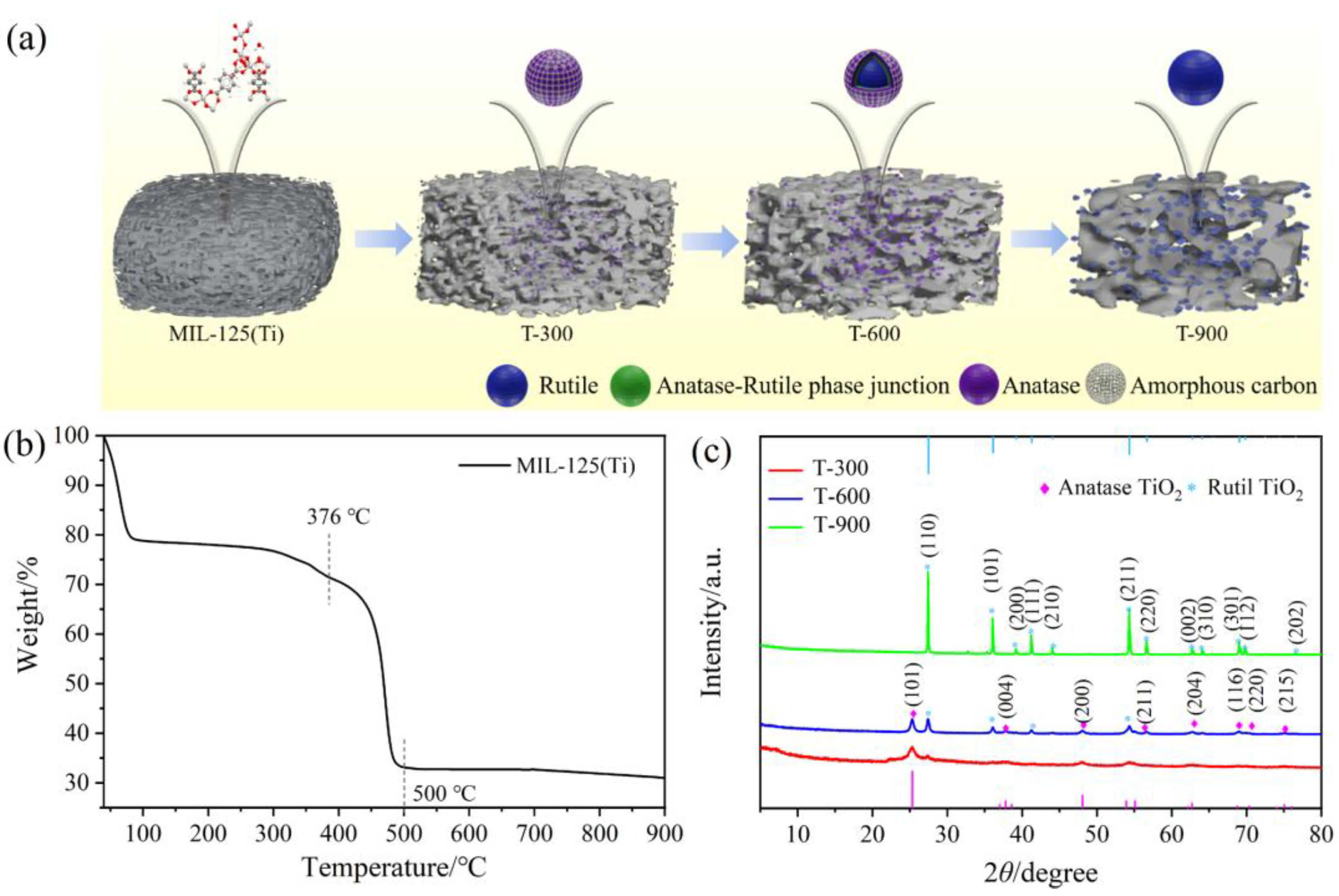
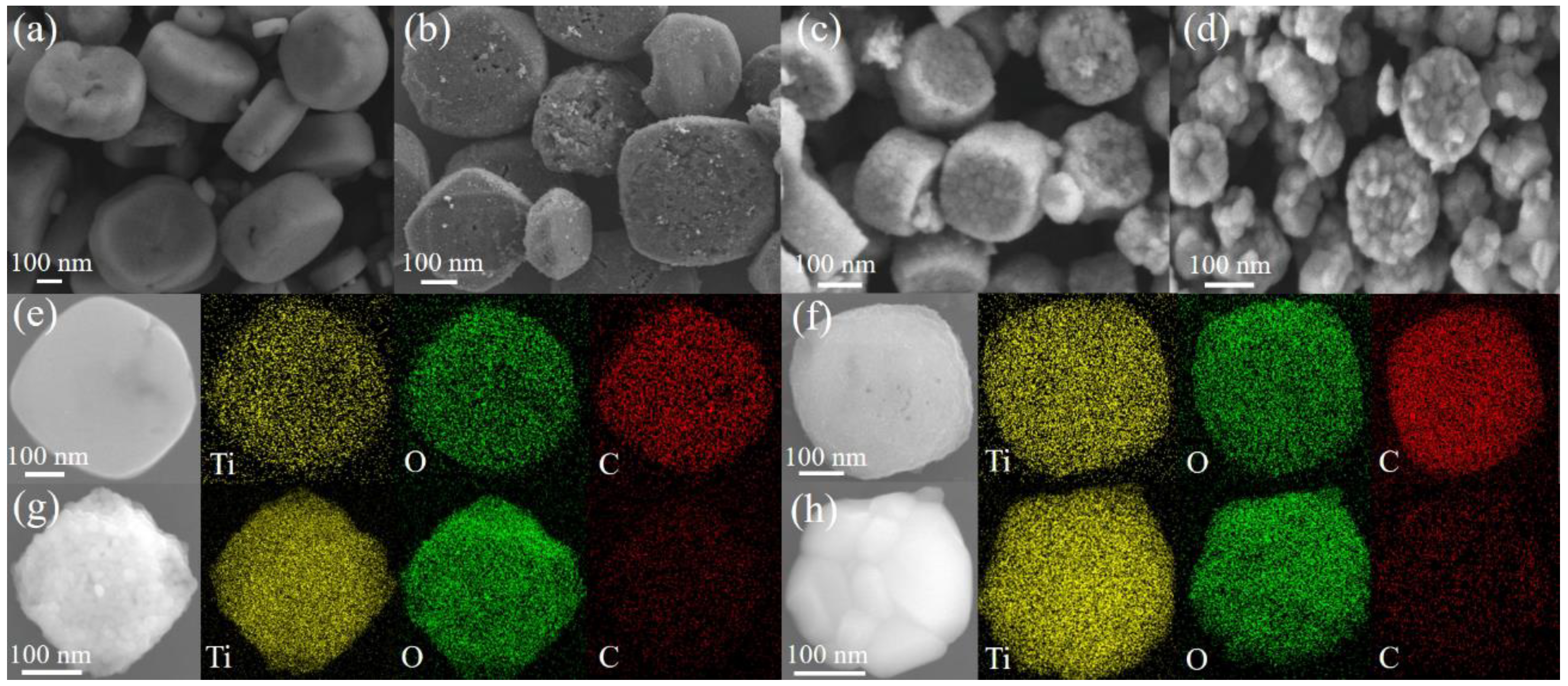


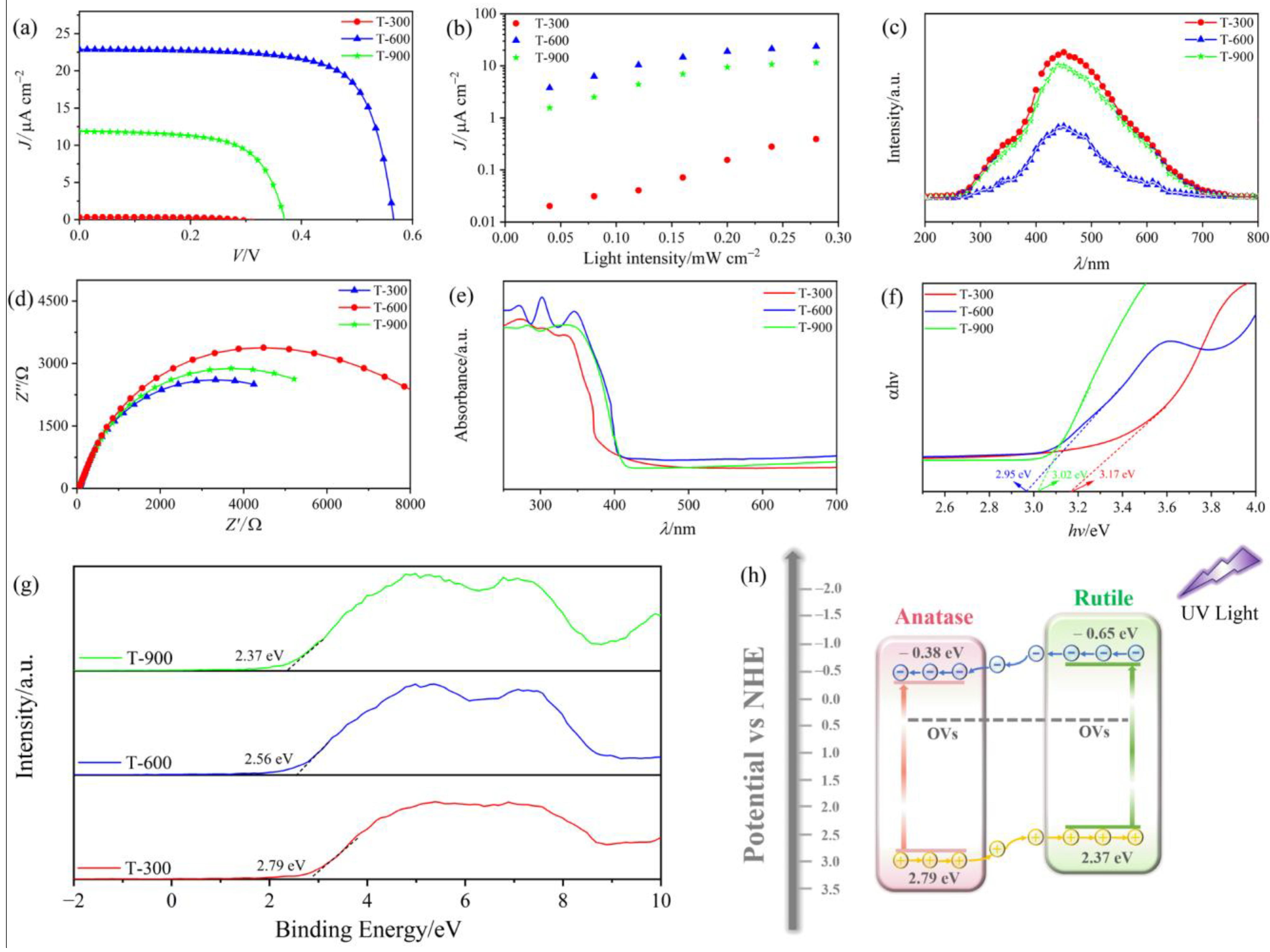


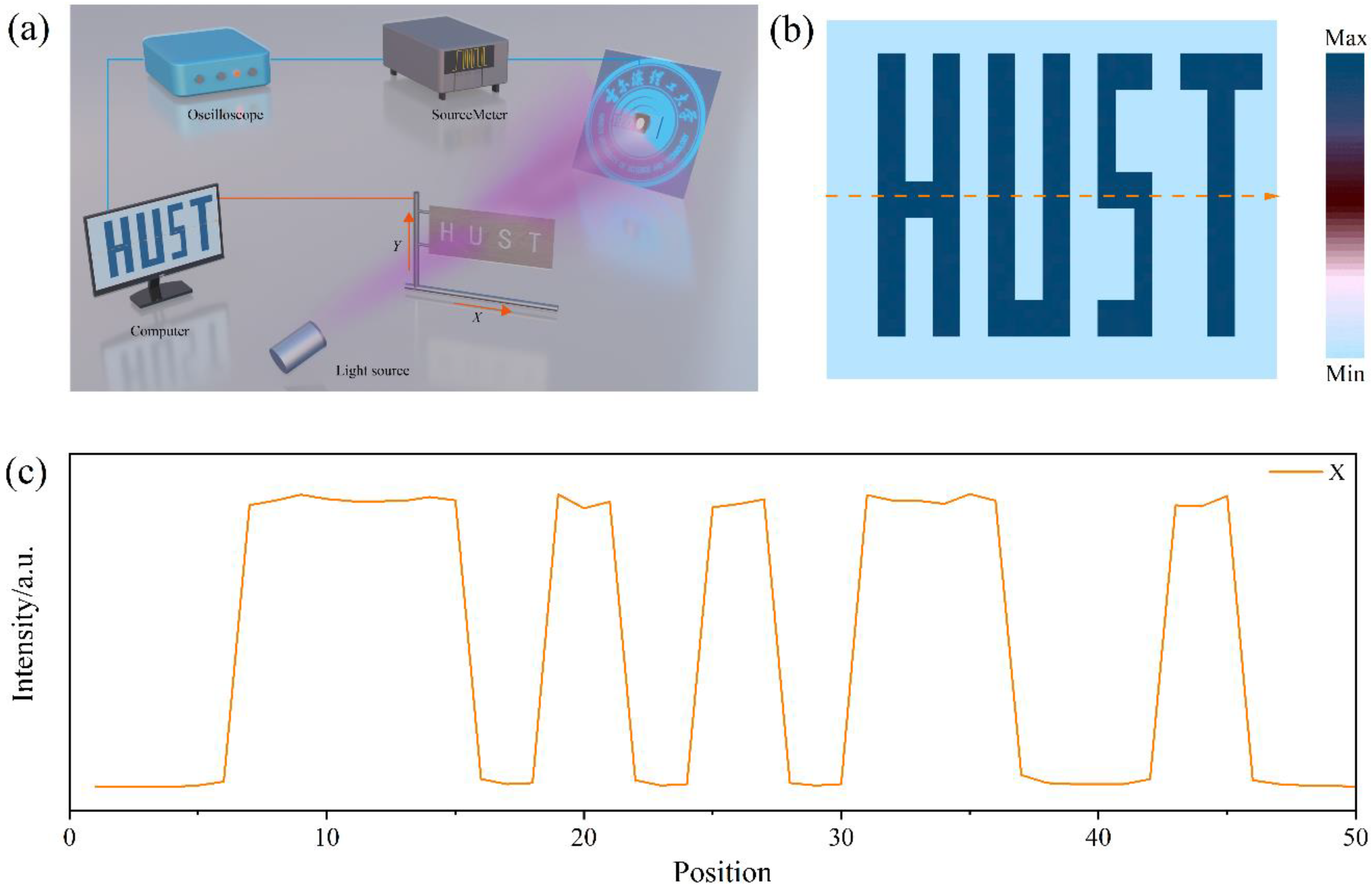
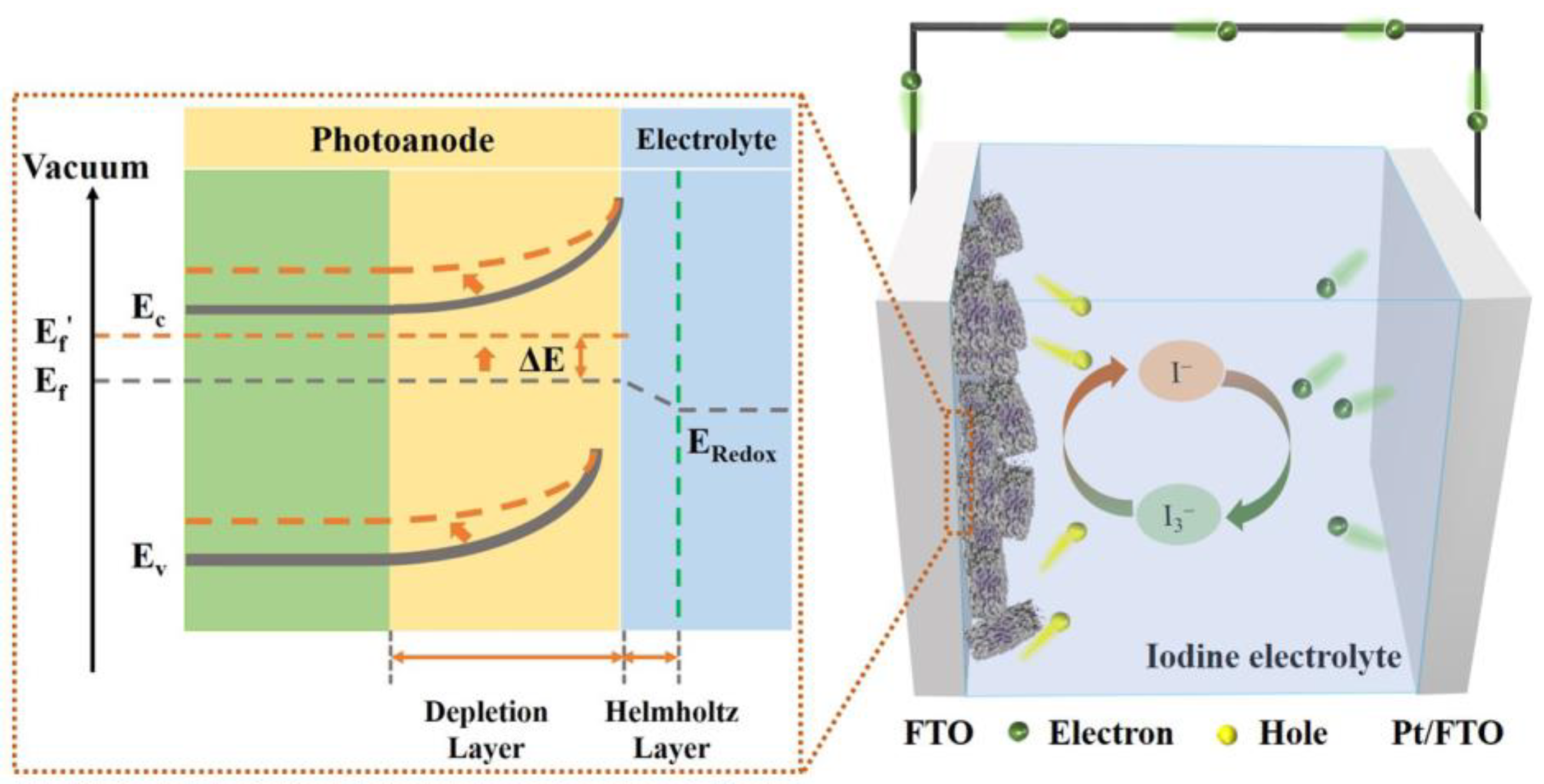
| Sample | Surface Area (m2 g−1) | Pore Size (nm) | WA/WR (%) | A-Phase Size (nm) | R-Phase Size (nm) | Carbon Content (%) |
|---|---|---|---|---|---|---|
| MIL-125(Ti) | 921.1 | 3.2 | − | − | − | 43.8 |
| T-300 | 246.7 | 3.6 | − | 10.5 | − | 38.5 |
| T-600 | 23.7 | 20.5 | 49.9/50.1 | 19.3 | 21.1 | 13.6 |
| T-900 | 1.4 | 17.4 | 0 | − | 66.2 | 8.7 |
Disclaimer/Publisher’s Note: The statements, opinions and data contained in all publications are solely those of the individual author(s) and contributor(s) and not of MDPI and/or the editor(s). MDPI and/or the editor(s) disclaim responsibility for any injury to people or property resulting from any ideas, methods, instructions or products referred to in the content. |
© 2024 by the authors. Licensee MDPI, Basel, Switzerland. This article is an open access article distributed under the terms and conditions of the Creative Commons Attribution (CC BY) license (https://creativecommons.org/licenses/by/4.0/).
Share and Cite
Ma, Y.; Huang, Y.; Huang, J.; Xu, Z.; Yang, Y.; Xie, C.; Zhang, B.; Ao, G.; Fu, Z.; Li, A.; et al. Optimizing Photoelectrochemical UV Imaging Photodetection: Construction of Anatase/Rutile Heterophase Homojunctions and Oxygen Vacancies Engineering in MOF-Derived TiO2. Molecules 2024, 29, 3096. https://doi.org/10.3390/molecules29133096
Ma Y, Huang Y, Huang J, Xu Z, Yang Y, Xie C, Zhang B, Ao G, Fu Z, Li A, et al. Optimizing Photoelectrochemical UV Imaging Photodetection: Construction of Anatase/Rutile Heterophase Homojunctions and Oxygen Vacancies Engineering in MOF-Derived TiO2. Molecules. 2024; 29(13):3096. https://doi.org/10.3390/molecules29133096
Chicago/Turabian StyleMa, Yueying, Yuewu Huang, Ju Huang, Zewu Xu, Yanbin Yang, Changmiao Xie, Bingke Zhang, Guanghong Ao, Zhendong Fu, Aimin Li, and et al. 2024. "Optimizing Photoelectrochemical UV Imaging Photodetection: Construction of Anatase/Rutile Heterophase Homojunctions and Oxygen Vacancies Engineering in MOF-Derived TiO2" Molecules 29, no. 13: 3096. https://doi.org/10.3390/molecules29133096





